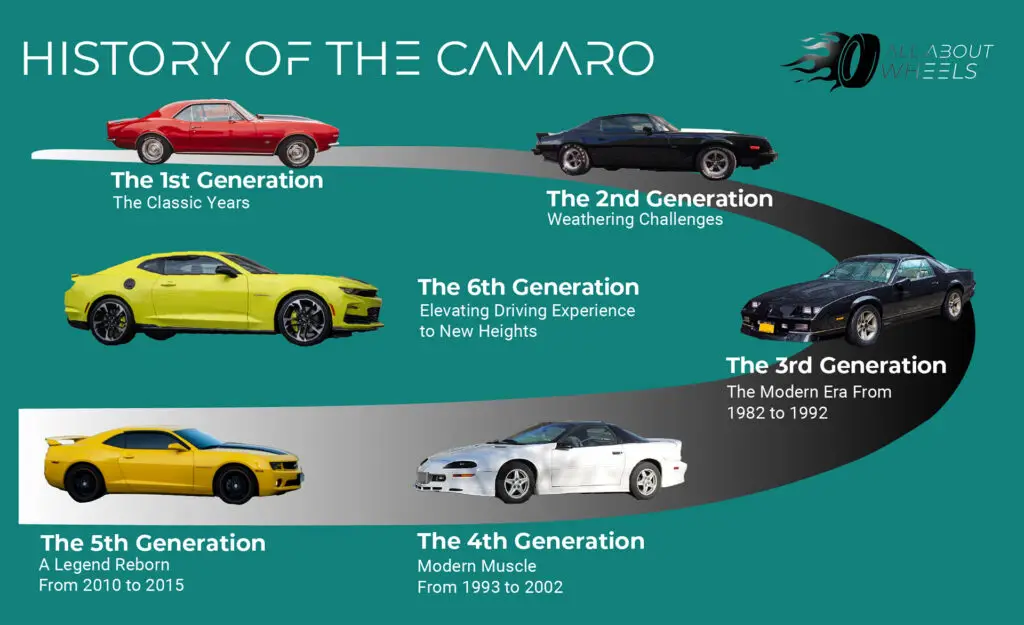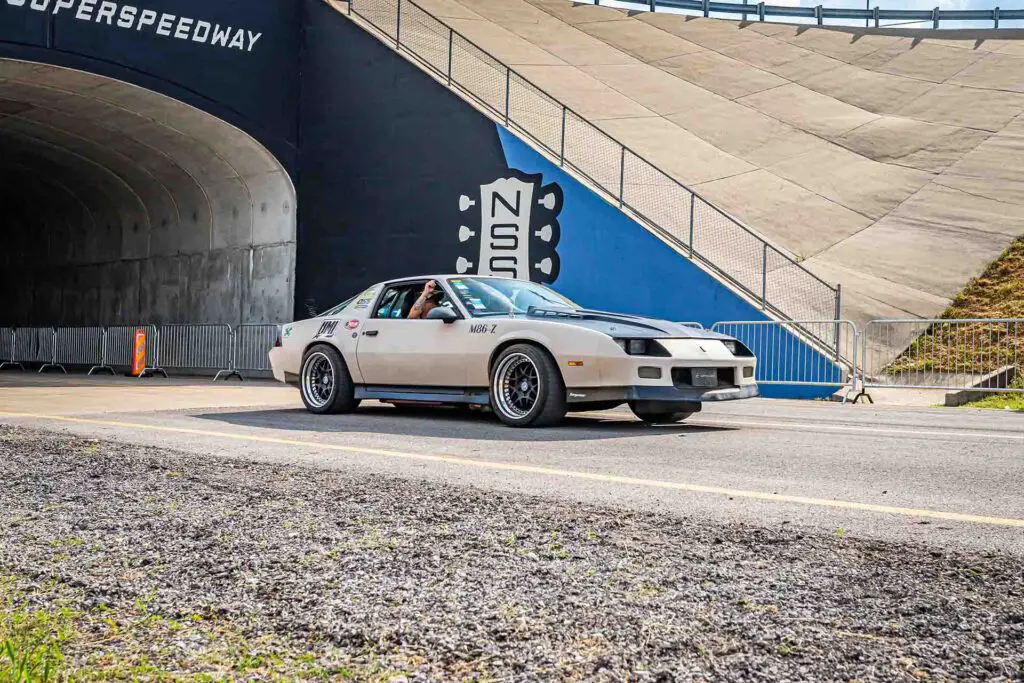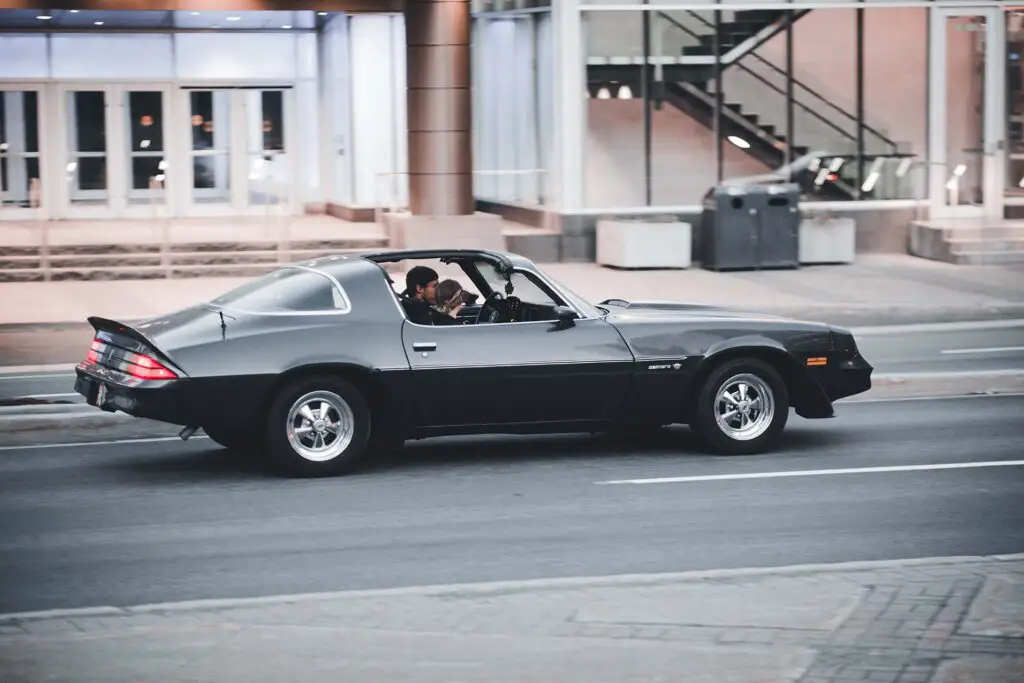The history of the Camaro goes beyond the story of a car. From its powerful engine to its iconic design, this vehicle has captured the hearts of automotive enthusiasts for decades. So, let’s go over the captivating history of this legendary American muscle car. Buckle up and join me in diving into the car’s milestones, innovations, and cultural impact.
The Camaro’s storied history spans generations, captivating automotive enthusiasts with its powerful presence. From its iconic debut in the 1960s to its triumphant return in the modern era, the Camaro has evolved, leaving an indelible mark on pop culture and igniting the thrill of the open road.
The Birth of an American Muscle Car – How the History of the Chevy Camaro Started
The year 1967 was important for the automobile industry since the Ford Mustang saw the light in June. As the Chevrolet had only Corvair that honestly couldn’t compete with it. So, naturally, Chevy had an idea of creating an American muscle vehicle that would be the top-notch one in the market.
The Camaro emerged as a fierce contender, blending sleek lines, a wide range of engine options, and an unmistakable presence on the road. It was the answer to an automotive zeitgeist, captivating enthusiasts and igniting a timeless love affair with speed and adrenaline.

First Generation – The Classic Years
The year was 1966, and amidst the fierce competition of the muscle vehicle era, Chevrolet unveiled the first-generation Camaro. Inspired by the growing popularity of agile and powerful vehicles, the Camaro quickly became a symbol of American automotive excellence. Its sleek lines, aggressive stance, and wide range of engine options made it an instant sensation.
Although manufactured in 1966, it was officially designated as a 1967 model. The first-generation Camaro had the shortest lifespan compared to its successors. It showcased a diverse range of engine options. Among them, the popular choice was the 230-cubic inch V-6, boasting 140 horsepower. However, the true powerhouse of this generation was the formidable 396-cubic inch V-8, unleashing a commanding 375 horsepower.
Design Features and Innovations of the First-Generation Camaro
Later, in 1968, the Camaro underwent a redesign, bidding farewell to vent windows and introducing the innovative Astro Ventilation air-inlet system. The new look featured pointed front grilles, divided rear tail lights, oval front running lights, enhanced suspension with multi-leaf rear springs, and improved shock absorbers.
The 1969 Camaro continued the trend with further exterior revisions, encompassing new sheet metal across every area except the hood and trunk lid. Deeper headlights, a robust V-shaped front grille, and a wider, lower profile added to its irresistible appeal.

Second Generation: Weathering Challenges
Over 11 years, the second generation of the Chevrolet Camaro experienced significant transformations driven by stricter federal safety regulations. This made drivers’ responsibilities even stickier. To comply, these vehicles underwent notable modifications. Including the addition of front bumpers, detuned engines with reduced horsepower, and the incorporation of catalytic converters in their exhaust systems.
Amidst these changes, there were silver linings such as enhanced drivability and improved fuel economy. Additionally, drivers were given the option to equip their Camaros with power windows and air-conditioning, further enhancing comfort and convenience.
The Impact of Changing Regulations, Fuel Crises, and Shifting Consumer Preferences
Although everything is innovative compared to the first car ever made, Chevy made quite an innovation with the second-generation Camaro. That’s how the pinnacle of power resided in the 1970 SS model, boasting an impressive output of 450 horsepower. However, as the 11-year era progressed, a downward trend in horsepower became apparent. By the end of this generation’s run, the most potent engine available delivered a modest 185 horsepower, signifying a notable decline in raw power compared to its earlier counterpart.

Third Generation: The Modern Era Begins From 1982 to 1992
The third evolution of the Chevrolet Camaro arrived as a hatchback coupe. It features a MacPherson strut front suspension for enhanced handling, a sleek aerodynamic shape, and rear coil springs for improved comfort. Drivers had a choice between a four-speed manual transmission or a three-speed automatic transmission. Offering versatile driving experiences and practically made a living without four-wheelers impossible.
The 1982 model’s crown jewel was the fuel-injected 5.0-liter V-8 engine, delivering a spirited 165 horsepower exclusively in the Z28 trim level. As the third generation drew to a close, the 1992 Camaro showcased moderate exterior design updates and a notable increase in power. Boasting an impressive 245 horsepower.
Introduction of Fuel Injection, Improved Handling, and Aerodynamics
The Chevy Camaro garnered the prestigious title of Motor Trend’s Car of the Year in 1982, solidifying its position as a top-tier sports model. As the third generation progressed, it witnessed incremental updates. Such as the introduction of a five-speed manual and five-speed automatic transmissions in 1983. Then, it transitioned to a steel hood in 1984 and the inclusion of the IROC-Z design package for the Z28 variant in 1985.
Engine options expanded and improved in 1986 while reintroducing the convertible body style in 1987 added another layer of allure. Subsequent alterations involved minor design refinements and electrical enhancements until the groundbreaking redesign for the fourth generation. No wonder why vehicle prices aren’t dropping when we had these kinds of innovative changes back then.

Fourth Generation: Embracing the Modern Muscle From 1993 to 2002
Debuting in 1993 and spanning until 2002, the fourth generation of the Camaro breathed new life into the original F-body design. While paying homage to its iconic predecessors, this iteration brought forth enhanced style.
Also, a streamlined aesthetic, and an array of options tailored to meet every driver’s needs. With its revitalized presence, the fourth-generation Camaro carried the torch of its heritage. Captivating enthusiasts with its sleek design and a wide range of customizable features.
The Introduction of the LT1 and LS1 Engines
The year 1993 marked the production of some popular imported cars in the US, but also the return of the Camaro, initially available solely as a coupe. The following year, in 1994, the convertible variant made a triumphant comeback. Accompanied by enhanced suspension and the introduction of a 3.4L V6 engine coupled with a standard five-speed manual transmission.
By 1995, the Camaro offered additional V6 engine options, delivering increased power to drivers. Notable changes arrived in 1998, presenting a fresh body design with a redesigned front clip. Along with a formidable 5.7L V8 engine, improved suspension systems, and larger brakes.
Throughout the remainder of the fourth generation, modifications were minimal, centering mainly on exclusive trim packages, expanded color choices, and interior redesigns. After 35 years since its original inception, the fourth generation drew to a close in 2002. Signaling an eight-year hiatus for the beloved Camaro due to declining sales. Despite this temporary absence, the Camaro’s legacy remained firmly intact, awaiting its triumphant return in the years to come.

Fifth Generation: A Legend Reborn From 2010 to 2015
Comparing classic and modern vehicles, of course, we all expect much better performance and safety fear, right? After a highly anticipated hiatus, the Camaro made its triumphant return in 2010. Showcasing a complete redesign that artfully blended the timeless aesthetic of the 1969 model with cutting-edge engineering advancements.
The resurgence of the Camaro was fueled by soaring demand, sparked by its prominent appearances in the 2007 blockbuster movie “Transformers.” The 2010 release boasted a standard 3.6L V6 engine, while the six-speed manual and automatic variants took performance to new heights with a formidable 6.2L V8 engine, delivering a thrilling driving experience.
The Retro-Inspired Design and the Blending of Classic Cues With Modern Technology
In 2011, Chevrolet introduced a convertible version of the Camaro, further expanding the lineup. The following year, 2012, witnessed the emergence of noteworthy models such as the ZL1, anniversary packages, and special trims, injecting new excitement into the Camaro family. The fifth generation persisted until 2015, with subsequent models from 2012 onward featuring subtle interior and exterior design enhancements.
While the engineering and reputation of the Camaro remained largely unchanged during this period. The updates added a touch of refinement and continued to solidify its position as a timeless icon. This being said, let’s compare the SS and ZL1 models in the table below.
| Engine | SS | ZL1 |
| Engine Capacity | 6.2 L V8 | Supercharged 6.2L V8 |
| Drive Type | Rear Wheel Drive | Rear Wheel Drive |
| Transmission | 6-speed manual | 6-speed manual |
| Horsepower | 455 @ 6,000 rpm | 650 @ 6,000 rpm |
Sixth Generation and Beyond: Sustaining the Legacy From 2016 to Present
Introduced in 2016, the latest and sixth generation of the Camaro ushered in an era of exhilarating high-performance driving. With a focus on reducing weight and enhancing fuel efficiency, the 2016 models showcased a lighter body structure and optimized engine systems. Inside the cabin, an interior redesign treated drivers to ambient lighting and premium materials, elevating the luxury feel.
However, if you’re an avid American car muscle lover, you must have heard that the GM announced the Collector’s Edition is the final chapter of the Camaro. Of course, no one is sure whether this is a marketing thing or not, but let’s see some of the features this last edition has:
- 650 lb.-ft. Torque and 650 horsepower,
- 10-speed paddle-shift automatic transmission,
- 1.7L Eaton supercharger,
- Variable Valve Timing and Direct Injection help improve fuel efficiency.
The Introduction of the Camaro ZL1 1LE and Other High-Performance Variants
The sixth generation of the Camaro introduced an enhanced version of the ZL1, showcasing a lighter body structure and elevated performance capabilities. The 1LE track performance package enhances the car’s on-track capabilities by incorporating an adjustable suspension system. Also, high-performance tires designed for extreme conditions and premium carbon fiber elements to further improve performance and aerodynamics.
In 2019, the Camaro underwent an impressive exterior rebranding, encompassing a fresh grille, revamped front and rear fascia, LED lights, and a modernized front-end design. While the 2020 and 2021 lineups presented minimal changes, they encompassed a comprehensive range of trim levels. The addition of the luxurious and sporty LT1 trim elevates the Camaro’s appeal to new heights.

History of Camaro Is Long and Prosperous
The history of the Chevrolet Camaro is a testament to its enduring legacy, marked by a journey that spans decades of automotive excellence. From its humble beginnings in the 1960s to its triumphant return in the modern era, the Camaro has remained a symbol of power, performance, and American ingenuity.
With each generation, it has evolved, adapting to changing times and pushing the boundaries of what a muscle car can be. Yet, through it all, the Camaro’s spirit remains unwavering, captivating hearts and fueling the dreams of enthusiasts around the world.








